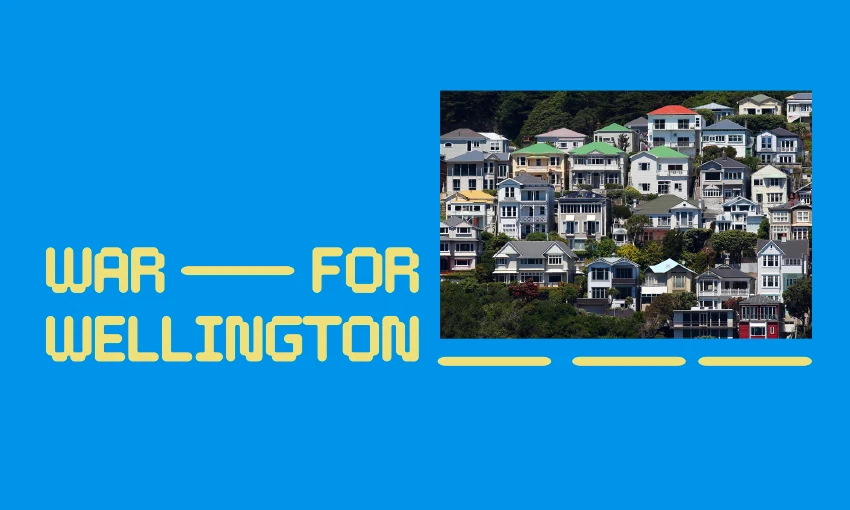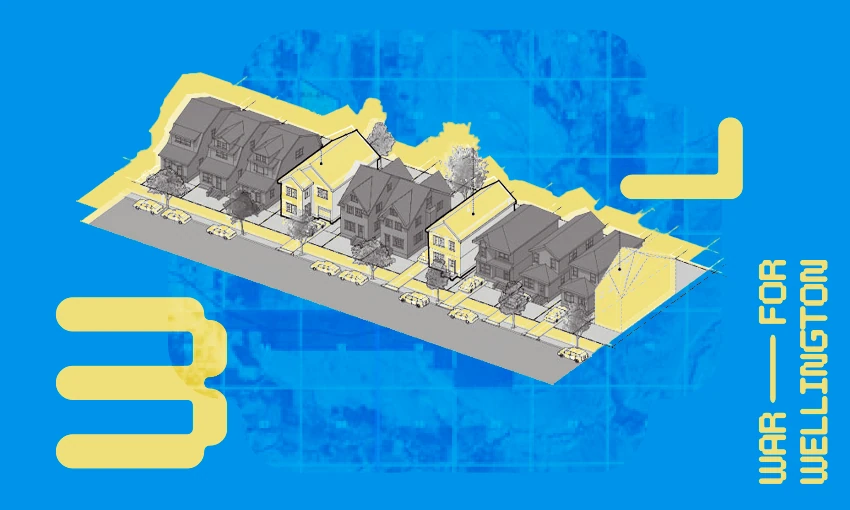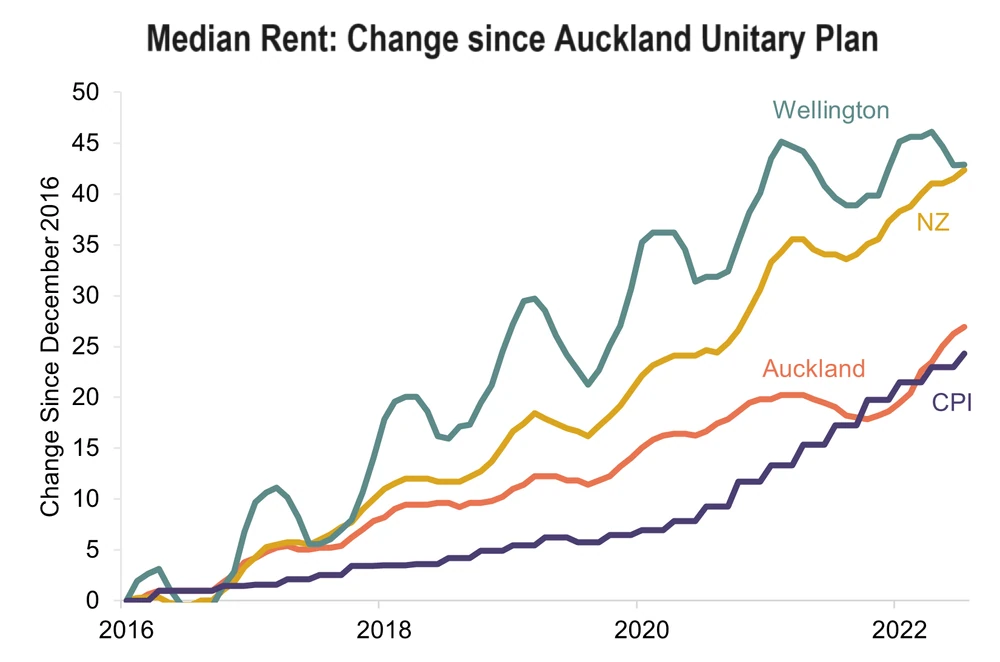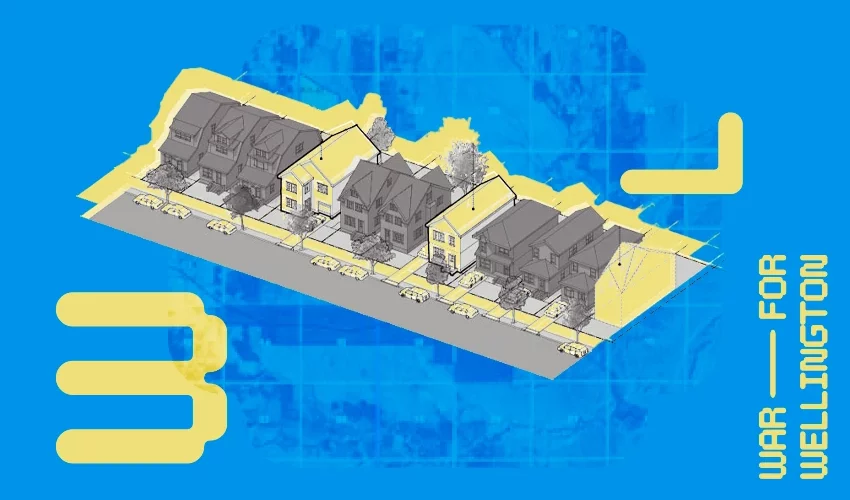A quick link in here for anyone that is interested but as yet have not seen: The SpinOff has announced a War for Wellington, which is doing everything that we here at the Eye of the Fish should have been doing (but of course, he gets paid for his work, but I don’t). It is brilliant, and you should go have a look at it now.

The first real article tackles the difficult subject of the looming District Plan update.
As some of you may guess, I’ve been following along with this for some time, but the tedium of the process will have turned a lot of people off. Joel MacManus puts it like this:
Welcome to the battlefront. This is the War for Wellington, the fight that will determine what kind of city we want to be. Specifically, will there be enough homes for everyone?
This war is not being fought on a battlefield. It’s being fought over hours and hours of council meetings, in thousands of pages of regulatory documents, and in a long campaign to lobby councillors for critical votes.
Wellington City Council is writing a new District Plan, which we have described as the single most important document for this city in our lifetime, and a once-in-a-generation opportunity to address the housing crisis by embracing density and allowing for more apartments and townhouses.
The next two months will be critical. Here’s everything you need to know to follow the War for Wellington.

Absolutely – nailed it. I suspect that as the following days go by, I may well part company with the opinions of Mr MacManus, but that remains to be seen. Is he young and issues drive, aimed firmly at the deleting of excessively large Heritage / Character areas, and thereby theoretically allowing room for more housing – which may or mayn’t have elements of affordability to it. As Joel says, the panel of Commissioners who have been listening to the last several months of feedback will be reporting back after Waitangi Day, on the 7th Feb, and it is only then that we may start to learn what the Panel of Worthies think – and what they propose to be the future of the city. These are the key issues that he identifies:
Centre city height limits: What should be the maximum height for office buildings and apartments in the middle of town? Should there be any maximum height at all?
Residential height limits: How tall can buildings be in residential neighbourhoods? Should different suburbs have different height limits?
Character protections: Right now, most of Wellington’s city-fringe suburbs (88% of land parcels in the inner-residential zone) designate as “character areas”. In these areas, demolishing pre-1930s homes without resource consent is prohibited. It is almost certain that the new plan will reduce the size of character areas. The question is: by how much?
What is mass rapid transit? The NPS-UD requires councils to allow six-storey buildings within a walking distance of mass rapid transit station. But what is a mass rapid transit station? Some people have argued the Johnsonville train is too slow to count as “rapid”. And what about Newtown and Island Bay, the site of the now-cancelled light rail, and the busy Number 1 bus route?
What is a walking distance? The NPS-UD doesn’t specify how big a walking distance is. It could be anywhere from a five-minute walk to 20 minutes. The council will have to choose its own definition, and it could make a huge difference to the amount of land that is zoned for apartments.
Heritage buildings: Any building listed by Heritage New Zealand only becomes protected once it’s added to the District Plan. This plan will decide if any heritage protections get added or removed.
Viewshafts: These are rules which prevent tall buildings in certain areas if they block views of certain landmarks. Like heritage and character buildings, viewshafts contribute to the city’s aesthetics but restrict the construction of new homes.

Below is another graph, showing just how much the number of Building Consents has changed since Auckland adopted its Unitary Plan, allowing more density, and Auckland developers responded accordingly, allowing for a few months for architects to girdle their loins and clean off their Rotrings (metaphorically speaking, of course), and design and submit new sets of plans for those brownfield sites.

As he says, that is not the end there. “Starting on February 7, the Independent Hearings Panel will release recommendations to the council over the course of six briefings. However, councillors are not bound by the panel’s decisions. They can make amendments to the plan, as long as they can win a majority vote at the final meeting on March 14. This is the crucial battleground to watch. Expect to see a lot of wheeling and dealing as councillors try to put their stamp on the plan and get the outcome they want.” I suspect that we at the Fish are going to be talking a lot about this issue over the next month or two. But in the mean time, go to The SpinOff and subscribe, and even donate to them too, while you’re there. It sounds as though Mainstream Western Media has finally found a useful purpose in life, other than as a venue for Click-Bait. Long may this continue. Three cheers to the SpinOff !!!





Although it looks like this fun could go on for a little longer,
“On Wednesday evening, councillor Tony Randle, supported by other councillors, filed a notice of motion to postpone consideration of the district plan until after long term plan decisions had been made. That could delay big decisions for the Wellington City Council as it weighs up two big pieces of work in the new year.
The notice of motion, if it passes a vote at the next council meeting on February 29, would mean district plan decisions would be delayed six to eight weeks, he said.
Councillor Teri O’Neill, not a signatory, described delaying the district plan as an “an egregious attempt“ by the right wing bloc to impede further housing.
The notice of motion was signed by Diane Calvert, Sarah Free, Iona Pannett, Nicola Young, and Randle.”
Crs Free and Pannett supporting this is a huge risk to the “left” control of council,
When you combine these 5 with others on the “tight” such as Chung, and Apanowicz and Brown , you get 8 votes,
The vote is on Feb 29h – so if Karl Tiefenbacher is elected on the 17th, it gives them 9, a clear majority (8 votes can be defeated by the Mayor’s casting vote)
To be fair, and ignoring the whole Left / Right aspect of the argument, this decision is THE most important to face the city and the consequences will be felt for at least the next 50 years. It is a decision that will take a lot of reading, and comprehending, by the Councillors AND by the public, before any hasty decisions are made.
Free and Pannett are not aligned with the left at all really. Sometimes on transport issues, but pretty much nothing else. They both got booted from the Green party (well Free jumped before she was pushed)
“Hasty decisions” Nemo? This discussion has been going on for 4 years. I wish.
Yes, but really, everything changes once the Independent Panel Commissioners report back. Everything up till now has been talk – and now, everything from now on is almost set in stone. At least, that’s my understanding. If the Council tick the box, then that’s it.
Next steps are, as far as I understand:
The IPC reports back.
The Council officers consider it, and usually confirms what the IPC has said.
The Councillors then vote on accepting what their officers have said.
And then it becomes the new, operative, District Plan.
I think that the time for saying “I don’t like this” or “I want more / less” is over.
The only legal channel left is if something is incorrect in terms of law.
No more opinions, just law.
Am I right?
Nemo, you are right. WCC can agree with the IHP, disagree, or disagree and put up a alternative but the alternative has to have already been suggested, it can’t be some totally new idea. In the case of disagreement, with or without an alternative, the matter goes to the Minister for the Environment who will make a final decision. There are no appeals to the Environment Court so the only other option is Judicial Review based on very limited procedural failings.
Actually the IHP reports are being drip fed over the next couple of weeks. You can follow along at https://wellington.govt.nz/your-council/plans-policies-and-bylaws/district-plan/proposed-district-plan/decision-making-process
Yeah, and seem to be coming down very much on the NIMBY side,
– J;Ville rail is not Rapid transit, therefore there are no walkable catchments needed and any intensification would be contrary to the NPS-UD,
CBD walkability stops halfway up Kelburn hill, and in Aro street, just beyond the shops – No density for Adams Terrace etc,
The original District Plan did not contemplate MDRS (three houses of three storeys allowed as of right with relaxed recession planes). The original planwas six storeys in walkable catchments and the status quo in remainder of residential zones. WCC adopted MDRS when it was passed across the entire former Inner and Outer Residential zones and even if given the option by the new government is unlikely to walk it back. As far as I am aware there was no push back on MDRS during the hearings. Even if you didn’t like it, it was at that point a fait accompli anyway. So there has significant upzoning of all residential sites across the city. I note that the City for People crowd seem to have the incorrect impression that MDRS is still contested when this is not the case. .
Yeah, MDRS blew great big holes in the premises of the proposed District plan (PDP) by upzoning everything everywhere al once …. ( It also blew great big holes in the LGWM light rail business case at the same time)
By allowing every 3 bedroom house in Karori (and all the other suburbs) to be demolished and replaced by 3 townhouses you legislate huge amounts of prospective development
The YimBys might want 6 stories throughout the inner city suburbs, but even if you zone for it, its always going to be cheaper to build 3 story townhouses, and the capital requirements for a developer are much easier to reach)…
it will end up being like the cross lease boom in places like Auckland in the 70s
Nothing in the reports yet on the recommended final overall height limit for the Central City. Some of the developers were arguing for unlimited height – I hope that gets firmly thrown out. Unlimited = height of stupidity.
The aspect of “Rapid Transit” is also a crucial one. With Brown Bishop having cancelled any chance of Light Rail, effectively forever, then it would seem to me that all the planned development around the designated “transport spine” south of the Wellington Station should also be cancelled. You simply can’t densify 6 or 8 storeys in Island Bay and then expect people to drive in or catch a bus.
Once again, NZ getting g things round the wrong way. Build the infrastructure first, then the buildings follow. You simply can’t do it the other way round or you get tied up in the mess like AKL is trying to do. How much easier it would have been to do the AKL CRL back in the 1950s when Mayor Robbie suggested it.
Nemo, I think you’ll find Robbie Rail was a late 60’s 70s project, ( he only became mayor in ’59)
Its actually a exact forerunner of what’s just happened to Auckland’s Light Rail
The Auckland Council proposed a central rail link, but needed central government funding,
Labour was elected in 1972 promising to build it, but they didn’t ..and in 1975 National (Muldoon) was elected, killing it in 76
https://www.greaterauckland.org.nz/2011/12/02/an-auckland-that-could-have-been-the-1972-auckland-rapid-rail-transit-plan/
OK, so 60s instead of 50s – but you’ve proved my point, that this is what we should be planning for right now, not putting it off according to Simpleton Simon. He’s too young and stupid and inexperienced to be able to grasp the importance of long-term planning…
This looks like it should be an interesting battle – and MacManus is not holding back. His latest piece says:
“The first recommendations for the future of Wellington’s housing are in, and they’re shit”
https://thespinoff.co.nz/politics/02-02-2024/the-first-recommendations-for-the-future-of-wellingtons-housing-are-in-and-theyre-shit
“That is just a minimum level; if Wellington City Council wanted to be more ambitious, it could. The panel did not seize that opportunity. In fact, most common houseplants possess more ambition than its report.” Meeeeoow Joel !! OK now i understand that The SpinOff is opinion, vs the Stuff Post is more like badly reported fact.
But I wouldn’t put all the blame squarely at the feet of the Panel of Commissioners, as he does. There was a hefty amount of lawyers at the hearings, backing up the self-centred interests of people like Khandallah Residents. He does make one interesting point though – that the Johnsonville Line is declared NON-Rapid, at 15 minute peak running, while the Kapiti and Hutt lines are deemed to be RAPID, yet they only run every 20 minutes at peak. I’d like to reread the legal mumbojumbo that managed to arrive at that conclusion !!
Their winding justification is on pager 50-60 of this,
https://wellington.govt.nz/-/media/your-council/plans-policies-and-bylaws/district-plan/proposed-district-plan/files/decision-making-process-on-the-proposed-district-plan/ihp-recommendation-reports/ihp-recommendation-report-1a.pdf
But its not a single test, its got 4 legs ….
MfE defined Rapid transit as ,,,,
“rapid transit service means any existing or planned frequent, quick, reliable and high-capacity
public transport service that operates on a permanent route (road or rail) that is largely
separated from other traffic”
https://environment.govt.nz/assets/Publications/Files/Understanding-and-implementing-intensification-provisions-for-NPS-UD.pdf
The 20 min frequency on Kapiti and Hutt are excused because there a plans to add more services in the future and increase the frequency, – there are no similar plans for the Jville line
In the Commissioners view, JVille also fails on the “quick” test as its actually faster to catch a bus from Johnsonville to wellington station than the train, ( ave rail speed on the line is 22-27km/h)
Though pretty sure hutt city also upzoned around the Melling line which can’t have that much more capacity.
The first section of the report is available to read here: https://wellington.govt.nz/your-council/plans-policies-and-bylaws/district-plan/proposed-district-plan/decision-making-process.
It is all over the shop. Veers between legalistic and sentimental nonsense.
This is a very typical misrepresentation of the yimby position
“aimed firmly at the deleting of excessively large Heritage / Character areas, and thereby theoretically allowing room for more housing – which may or mayn’t have elements of affordability to it.”
The point is that all else being equal, increased supply drives down prices overall. Whether or not any of the additional new houses are built are “affordable” the effect of adding supply has a negative impact on house prices.
Here is a discussion in a SF context: https://www.noahpinion.blog/p/yuppie-fishtanks-yimbyism-explained
I feel I just need to post this here:
https://www.youtube.com/shorts/NXGFtcjjrQo
Just as 40 years “Yes Minister” became an insight into the process of Bureaucracy – and of the movement of public service policy making,
So to has Utopia cemented its position as a exemplary teaching tool for those wanting to understand the planning and infrastructure Development process,
https://www.youtube.com/watch?v=x01GnqjqAvI
Or if you are into sprawl, you cant go past
https://www.youtube.com/watch?v=DcXatpW7Fjc&t=19s
Savagely accurate. Down the track…
A couple more updates to War for Wellington:
https://thespinoff.co.nz/politics/09-02-2024/a-rare-moment-of-unity-mps-hate-wellingtons-new-housing-report
This mentions “Councillor Ben McNulty couldn’t resist an early dig at the panel’s ruling that enabling more housing wouldn’t lead to more housing, asking: “Is it the view of the panel that if there was a shortage of bread rolls at KFC Johnsonville, supplying more rolls at KFC would not have any impact on the shortage of bread rolls?”
“Sean Audain, the council’s strategic planning manager, answered diplomatically: “Our job is to impartially put before you the advice of the panel, absent of the views of officers. Given the panel didn’t actively discuss KFC, we cannot possibly consider it.”
“The independent hearings panel released its third report on Wednesday evening, focused on the centre city. It was less dramatic than the first two – the most significant recommendation was to replace the 42m central city height limit with a “height threshold”, which developers could go over if they met certain criteria, a potential win for housing supply.”
And there is also this one:
https://thespinoff.co.nz/wellington/08-02-2024/city-for-people-the-five-things-we-want-from-wellingtons-new-district-plan
City for People is calling on Wellington City Council to do five things:
Raise building height limits in the city centre or (ideally) remove them altogether
Exciting cities like New York, Amsterdam, and Singapore have vibrant city centres because lots of people are able to choose to live close to each other. But right now in Wellington, we don’t have enough apartments for people to make this choice. There are parts of the city centre where the maximum height allowed is six storeys. It’s giving… small town energy. In the capital city.
Take a reality check on what a ‘walkable’ distance is
Central government says councils must allow buildings of at least six-storeys within “walkable catchments” of urban centres and any “mass rapid transit” stops (public transport stops with frequent services, like train stations). This would enable more homes in the well-connected suburbs. But the definition of “walkable”, according to the draft District Plan? Ten minutes. What a joke. Wellingtonians walk everywhere. I channel Edmund Hillary every time I hike home – its why I’ve got such strong calves. “Walkable” should be at least fifteen minutes.
Recognise that the Johnsonville train line and the Newtown bus route are ‘mass-rapid transit’ routes
If a train is not mass rapid transit, then what is?
Apply the Medium Density Residential Standards throughout the city.
These standards allow three homes of up to three storeys on any section by default, unless there is good reason for an exemption. Applying these standards everywhere would help distribute development across the city, rather than concentrating it into a few places. In 2016, Auckland applied similar “gentle density” zones in large parts of the city. Six years on, this zoning change was found to have made a significant contribution to lowering rents.
Keep special character areas the same size agreed to in the Spatial Plan in 2021
The Spatial Plan made a sensible compromise, preserving well-maintained pockets of Wellington’s history, while also allowing more homes in the suburbs closest to the city centre. Our city has already had that conversation and made that decision, why rehash it now?
The bottom line is, we need to build more homes, and denser urban living is the most sensible way to do it. Building more homes is the only way we can meaningfully address the housing crisis, and changing the zoning rules is a huge piece of that puzzle. It’ll help us finally fix the damn pipes, too. More people living in Wellington means more people paying rates to help pay for infrastructure. Denser urban form would also save the city money – it’s cheaper and more efficient to deliver infrastructure to homes that are closer together.
As far as I can see the IHP has recommended MDRS be applied uniformly across the city. While it may be somewhat harder to demolish in the heritage areas, it is not impossible as is being portrayed by City for People and replacement buildings can be three storeys with the MDRS envelope. In some areas around centres the IHP have recommended four storeys.
And lastly, this, which should have been before those other two:
https://thespinoff.co.nz/politics/07-02-2024/the-second-report-on-the-future-of-wellingtons-housing-is-out-and-its-even-shittier-than-the-first
Some choice headlines from this, include:
There’s no point trying to make the inner suburbs more affordable
Too many houses are allowed already
House prices are too low
More homes won’t reduce per-home infrastructure costs
Restricting density won’t create sprawl
There’s no evidence sprawl leads to more emissions
Oriental Bay is accidentally upzoned due to a weird loophole
I’m still posting up these updates so that I can find them again later – hopefully useful for you lot reading them as well. Some provocative stuff sometimes! This one in particular:
https://thespinoff.co.nz/wellington/19-02-2024/why-demolishing-character-homes-would-be-better-for-the-environment-actually
And this one here, from Stu Donovan, who used to write for Greater Auckland many years ago:
https://thespinoff.co.nz/politics/15-02-2024/opinion-wellingtons-housing-panel-is-out-of-step-with-the-economic-evidence
And also this – keep them coming Joel !
https://thespinoff.co.nz/wellington/16-02-2024/how-wellingtons-housing-panel-reached-its-anti-housing-conclusions
The latest piece on the SpinOff, claiming that Jane Jacobs would have been interested in Wellington’s housing woes, is a much different argument from what the SpinOff has been saying so far.
https://thespinoff.co.nz/wellington/20-02-2024/what-would-jane-jacobs-think-of-wellingtons-new-district-plan
The author of this piece, Stephen Maslin, claims that Jacobs would have supported the call for More Homes is on dodgy ground. Jane Jacobs famously was a thorn in the side of Robert Moses and his plan to demolish large swathes of New York, for the dual purposes of new highways as well as clearing out slum housing. Jacobs protested and wrote her most famous work “The Death and Life of Great American Cities” in an effort to battle Moses and his plans to destroy the existing city life.
By contrast, advocating for a reduction in the size of Character Areas would logically also advocate for the destruction of many of the existing houses. You can’t have it both ways. Yes, people are the life blood of a city, and yes, some of their existing homes are crap, but demolishing their homes so that you can fit more people into the city is going to be just as destructive in its own way. Maslin – want to respond?
A Spinoff piece on Chrisp Bisho,
https://thespinoff.co.nz/politics/27-02-2024/a-housing-minister-for-the-new-city
Salient points:
“Bishop made his case for housing reform based on three arguments: First, larger cities are more powerful economic engines. He pointed to one study showing that doubling a city’s population increases the per-capita productivity by 15%. Second, more housing supply would reduce the $5-billion-a-year cost of government housing subsidies. Third, a moral case, that a housing system that results in thousands of people living in cars and massive intergenerational inequity is simply wrong.”
“A new cabinet paper, released in conjunction with the speech, is full of similarly ambitious rhetoric. “Housing affordability is arguably the single most pressing economic, social and cultural problem facing this government,” he wrote. “My goal is to flood urban housing markets for Tier 1 and 2 councils with land for development.” “
And there is this:
https://thespinoff.co.nz/politics/22-02-2024/the-old-town-and-the-new-city-a-battle-of-two-wellingtons#
“The race between Rogers and Tiefenbacher wasn’t about the Greens vs National. It wasn’t about left vs right. It wasn’t even about pipes vs bikes. More so than any recent election, it was a tussle between two amorphous factions that have defined Wellington local body politics for decades. For the sake of simplicity, let’s call them the New City and the Old Town.”
“The New City are the creatives, students, hipsters and yo-pros. They want to live an urbane lifestyle, with trendy cafes, thrift shops and experimental gigs. They look at Melbourne and Amsterdam with their trams, bike lanes and apartments, and aspire for Wellington to be like that.”
“The Old Town are long-time homeowners, deeply rooted in their community, who are uncomfortable with the way it is changing. They don’t want Wellington to become a big city – or think it would fail if it tried. They look at regional towns like Palmerston North or New Plymouth with their ample parking, wide roads, and quiet suburban neighbourhoods, and aspire for Wellington to be like that (while retaining the amenities of city life).”
I really am beginning to tire of this style of divisive journalism. Tiefenbacher literally started a ‘trendy cafe’. As a businessman, why on earth would he favour a stagnating city.